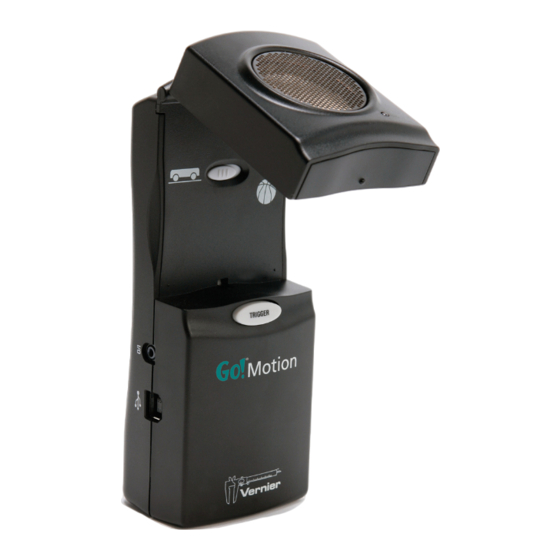
Table of Contents
Advertisement
Quick Links
Go!
Motion
(Order Code GO-MOT)
Go! Motion is used to collect position, velocity and
acceleration data of moving objects. Go! Motion's USB port
allows for direct connection to a computer's USB port, which
simplifies experiment set up. Students can study a variety of
motions with Go! Motion, including
•
Walking toward and away from Go! Motion.
•
Dynamics carts moving on track.
•
Objects in simple harmonic motion, such as a mass hanging on a spring.
•
Pendulum motions.
•
Objects tossed upward or dropped.
•
A bouncing object.
This is motion data collected with Logger Pro
Motion of a cart on a ramp
Go! Motion is compatible with the following equipment:
•
Directly to the USB port of a computer
•
Vernier LabQuest
™
•
Vernier LabPro
Texas Instruments CBL 2
® ,
MDC-BTD, sold separately)
•
USB port of a TI-84 Plus calculator with the proper cable (order code GM-
MINI, sold separately)
•
Calculator I/O port of TI-83 Plus or TI-84 Plus graphing calculators with the
proper cable (order code GM-CALC, sold separately)
•
Universal Lab Interface with the proper cable (order code ULI-MDC, sold
separately)
®
and a computer.
with the proper cable (order code
™
NOTE: This product is to be used for educational purposes only. It is not
appropriate for industrial, medical, research, or commercial applications.
What is Included with Go! Motion?
Go! Motion ships with the detector, a USB cable that
connects Go! Motion to a standard USB port, and a CD
containing Logger Lite software. These materials are
everything that you need to use Go! Motion with a USB-
compatible computer.
Quick Start Guide
To get started on a computer right away, follow these easy steps.
1. Install the Logger Lite software.
2. Connect the square end of the USB cable to the USB port on the left side of
Go! Motion.
3. Connect the other end of the cable to a USB port on your computer.
4. Start Logger Lite, and you are ready to collect data. Note: Go! Motion can also be
used with Logger Pro software.
How Go! Motion Works
This Motion Detector emits short bursts of ultrasonic sound waves from the gold foil
of the transducer. These waves fill a cone-shaped area about 15 to 20° off the axis of
the centerline of the beam. Go! Motion then "listens" for the echo of these ultrasonic
waves returning to it. The equipment measures how long it takes for the ultrasonic
waves to make the trip from Go! Motion to an object and back. Using this time and
the speed of sound in air, the distance to the nearest object is determined.
Note that Go! Motion will report the distance to the
closest object that produces a sufficiently strong
echo. Go! Motion can pick up objects such as
chairs and tables in the cone of ultrasound.
The sensitivity of the echo detection circuitry
automatically increases, in steps, every few
milliseconds as the ultrasound travels out and back.
This change in sensitivity enables the detection of weaker signals.
Features of Go! Motion
•
Go! Motion is capable of measuring objects as
close as 0.15 m and as far away as 6 m. The
short minimum target distance allows objects
to get close to the detector, which reduces
stray reflections.
2
Advertisement
Table of Contents

Summary of Contents for Vernier Go!Motion
- Page 1 Go! Motion is compatible with the following equipment: This change in sensitivity enables the detection of weaker signals. • Directly to the USB port of a computer Features of Go! Motion • Vernier LabQuest ™ • • Vernier LabPro Texas Instruments CBL 2 with the proper cable (order code ®...
- Page 2 The other sensitivity setting, which we call “track”, works well when studying motion of carts on tracks like the Vernier Dynamics System, or motions in which you want to Camera Screw Mount Motion Detector Clamp (sold separately) eliminate stray reflections from object near to the sensor beam.
- Page 3 • Using Go! Motion with LabQuest With a force sensor to study collisions and impulse • With a force sensor to study simple harmonic motion This sensor can also be connected directly to LabQuest: • With a light sensor to study the inverse square law 1.
- Page 4 • www.vernier.com Rev.10/3/07 Logger Pro, Logger Lite, Vernier LabQuest, Vernier LabPro, Go! Link, Vernier EasyLink and other marks shown are our trademarks or registered trademarks in the United States. CBL 2 and CBL, TI-GRAPH LINK, and TI Connect are trademarks of Texas Instruments.
















Need help?
Do you have a question about the Go!Motion and is the answer not in the manual?
Questions and answers